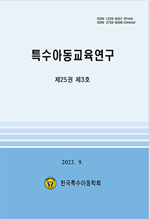- 영문명
- A Characteristics of Picture Symbolic Expression of Four-year-old Infants
- 발행기관
- 한국특수아동학회
- 저자명
- 권회연 박성지
- 간행물 정보
- 『특수아동교육연구』제21권 제2호, 141~161쪽, 전체 21쪽
- 주제분류
- 사회과학 > 교육학
- 파일형태
- 발행일자
- 2019.06.30

국문 초록
연구목적: 본 연구는 4세 유아들이 의사소통 수단으로 표현한 동사, 형용사, 대명사 그림상징의 특성을 분석함으로써 향후 유아나 발달수준이 낮은 학습자를 위한 그림상징 개발 과정에서 활용할 수 있는 기초자료를 마련하기 위한 목적으로 수행되었다. 연구방법: 본 연구를 위해 4세 유아 25명을 대상으로 그림상징 표현 기술을 분석하였으며, 목표 어휘는 동사 ‘먹다’, 형용사 ‘크다’, 대명사 ‘무엇’을 선정하였다. 먼저 또래 친구들과 의사소통할 목적으로 그림상징을 표현하도록 요구한 후, 아동이 그림을 설명하도록 하였다. 아동이 표현한 그림은 Light 등(2008)이 제시한 DAS(Developmentally Appropriate Symbols)의 6가지 특성인 구체성, 친근성, 맥락성, 전체성, 색상, 초점의 요소에 근거해 특성을 분석하였다. 연구결과: 동사 ‘먹다’에서는 25명의 유아 모두에게서 구체성, 친근성, 맥락성의 특성이 나타났다. 전체성은 80%의 아동에게서 나타났으며, 색깔은 84%, 초점은 32%의 유아에게서 나타났다. 대부분의 아동들은 친숙한 상황에서 자신이 무엇을 먹는 장면을 좋아하는 사람과 먹는 상황을 표현하였다. 형용사 ‘크다’에서 구체성과 친근성은 25명 중 100%의 아동에게 나타났으며, 맥락성은 64%, 전체성은 88%, 색깔과 초점은 각각 80%, 72%에 나타났다. 유아들은 큰 거인을 그리거나, 키가 큰 사람과 작은 사람을 대비시키는 그림을 그렸다. 대명사 ‘무엇’에서는 전체 25명의 유아 중 구체성, 친근성, 맥락성은 100%의 유아들에게서 나타났으며, 전체성은 84%에서 나타났다. 색깔과 초점은 각각 84%, 80%로 나타났다. 결론: 유아들은 주로 물음표를 강조하여 표현하여 자신이 궁금해 하는 얼굴 표정, 상자나 선물상자 등을 표현하여 자신이 친숙한 장면이나 활동을 표현하려고 하였다. 4세 유아들이 표현한 그림상징은 성인의 입장에서 개발된 그림상징과 내용적으로 많은 차이를 보였으며, 내러티브를 통해 자신의 부족한 표상능력을 보완하여 표현하려는 모습을 보였다. 이와 같은 연구결과를 토대로 그림상징 개발에 주는 시사점과 후속연구에 대한 제언을 제시하였다.
영문 초록
Purpose: The purpose of this study is to analyze the symbolic expression technique to investigate the characteristics of pictorial symbol considering infant concept development and communication perspectives. Method: The participants on this study were 25 toddlers, being 4-year-old children on preschools. As well, they expressed three basic vocabulary ‘eat’, ‘big’, ‘what’ to pictures owing to perceive easily. The pictures were analyzed by six factors(concreteness, familiarity, context, wholeness, color, focus) on DAS(Developmentally Appropriate Symbols) by Light et al. (2008). Results: The results were as follows: First, the ‘concreteness’, ‘familiarity’, and ‘contextuality’ expressed in the verb 'Eat' appeared in all 25 children. ‘Wholeness’ was found in 80% of children, and ‘color’ was found in 84% of children. The ‘focus’ appeared in 32% of infants. Most children expressed a picture of what they were eating at home or at familiar settings, and especially expressed their favorite foods with a person they liked. In the adjective 'big', the ‘concreteness’ and ‘familiarity’ were found in 100% of 25 children. The ‘contextuality’ was 64%, the ‘wholeness’ was 88%, and the ‘color’ and ‘focus’ were 80% and 72%, respectively. Infants tended to draw tall people or to contrast tall people and small ones. In the pronoun 'what', the ‘concreteness’, ‘familiarity’, and ‘contextuality’ of the 25 infants appeared in 100% of the infants and the ‘wholeness’ was 84%. ‘Color’ and ‘focus’ were 84% and 80%, respectively. Conclusion: The infants mainly expressed the question mark by emphasizing the expression of the face with a box or a gift box. It is necessary to select pictorial symbols suitable for children's linguistic conceptual level and appropriate distinguishing elements.
목차
Ⅰ. 서론
Ⅱ. 연구 방법
Ⅲ. 연구 결과
Ⅳ. 논의 및 제언
참고문헌
키워드
해당간행물 수록 논문
참고문헌
최근 이용한 논문
교보eBook 첫 방문을 환영 합니다!

신규가입 혜택 지급이 완료 되었습니다.
바로 사용 가능한 교보e캐시 1,000원 (유효기간 7일)
지금 바로 교보eBook의 다양한 콘텐츠를 이용해 보세요!




